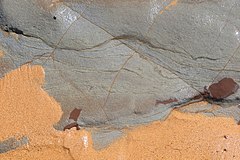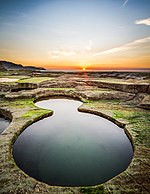| Bulgo Sandstone | |
|---|---|
Stratigraphic range: | |
 Outcrop of the Bulgo Sandstone at
Long Reef in
New South Wales | |
| Type | Geological formation |
| Unit of | Narrabeen Group |
| Underlies | Bald Hill Claystone |
| Thickness | up to 100 metres (330 ft) |
| Location | |
| Location | Sydney Basin |
| Country | Australia |
| Extent | Sydney |
Bulgo Sandstone is a sedimentary rock occurring in the Sydney Basin in eastern Australia. This stratum is up to 100 metres thick, formed in the early Triassic ( Olenekian). A component of the Narrabeen Group of sedimentary rocks. It consists of layers of fine to medium-grained quartz- lithic sandstone, with lenticular shale interbeds.

Often seen as a grey-green colour when exposed, the Bulgo sandstone contains a high level of particles of volcanic rocks, and is dissimilar to other Sydney sandstones, such as Hawkesbury sandstone and Newport Formation. The rock breaks down to create a relatively fertile clayey soil. These soils contribute to the rainforest growth in the northern Illawarra. Bulgo sandstone may be seen at the "figure eight" rock pool at Royal National Park and at Long Reef in the northern Beaches in Sydney. A fossil of the giant salamander (Bulgosuchus gargantua) was found at Long Reef. [1] [2] [3]
Paleofauna and paleoflora
- Bulgosuchus gargantua - Mandible and femur. [4]
- Capitosauria indet. - Isolated remains. [4] [5]
- Dicroidium - Abundant remains. [5]
- Non- teleost fish - Isolated remains. [5]
- Proterosuchidae indet. - Two anterior dorsal vertebrae. [6] [5]
See also
References
- ^ "Bulgo Sandstone". Geo Science Australia. Australian Government. Retrieved 17 May 2016.
- ^ Gregory Retallack. "Triassic Paleosols in the Upper Narrabeen Group of New South Wales. Part II: Classification and Reconstruction" (PDF). Blogs.uoregon.edu. Retrieved 1 February 2016.
- ^ John Martyn. "Towards a Richer Understanding of Local Geology, STEP INC, Retrieved February 22nd, 2018".
- ^ a b Damiani, Ross J. (1999). "Giant temnospondyl amphibians from the Early to Middle Triassic Narrabeen Group of the Sydney Basin, New South Wales, Australia". Alcheringa. 23 (2): 87–109. Bibcode: 1999Alch...23...87D. doi: 10.1080/03115519908619324.
- ^ a b c d Niedźwiedzki, Grzegorz; Bajdek, Piotr; Owocki, Krzysztof; Kear, Benjamin P. (2016). "An Early Triassic polar predator ecosystem revealed by vertebrate coprolites from the Bulgo Sandstone (Sydney Basin) of southeastern Australia". Palaeogeography, Palaeoclimatology, Palaeoecology. 464: 5–15. Bibcode: 2016PPP...464....5N. doi: 10.1016/j.palaeo.2016.04.003. ISSN 0031-0182.
- ^ Kear, Benjamin P. (2009). "Proterosuchid archosaur remains from the Early Triassic Bulgo Sandstone of Long Reef, New South Wales". Alcheringa: An Australasian Journal of Palaeontology. 33 (4): 331–337. Bibcode: 2009Alch...33..331K. doi: 10.1080/03115510903270944. ISSN 0311-5518.
| Bulgo Sandstone | |
|---|---|
Stratigraphic range: | |
 Outcrop of the Bulgo Sandstone at
Long Reef in
New South Wales | |
| Type | Geological formation |
| Unit of | Narrabeen Group |
| Underlies | Bald Hill Claystone |
| Thickness | up to 100 metres (330 ft) |
| Location | |
| Location | Sydney Basin |
| Country | Australia |
| Extent | Sydney |
Bulgo Sandstone is a sedimentary rock occurring in the Sydney Basin in eastern Australia. This stratum is up to 100 metres thick, formed in the early Triassic ( Olenekian). A component of the Narrabeen Group of sedimentary rocks. It consists of layers of fine to medium-grained quartz- lithic sandstone, with lenticular shale interbeds.

Often seen as a grey-green colour when exposed, the Bulgo sandstone contains a high level of particles of volcanic rocks, and is dissimilar to other Sydney sandstones, such as Hawkesbury sandstone and Newport Formation. The rock breaks down to create a relatively fertile clayey soil. These soils contribute to the rainforest growth in the northern Illawarra. Bulgo sandstone may be seen at the "figure eight" rock pool at Royal National Park and at Long Reef in the northern Beaches in Sydney. A fossil of the giant salamander (Bulgosuchus gargantua) was found at Long Reef. [1] [2] [3]
Paleofauna and paleoflora
- Bulgosuchus gargantua - Mandible and femur. [4]
- Capitosauria indet. - Isolated remains. [4] [5]
- Dicroidium - Abundant remains. [5]
- Non- teleost fish - Isolated remains. [5]
- Proterosuchidae indet. - Two anterior dorsal vertebrae. [6] [5]
See also
References
- ^ "Bulgo Sandstone". Geo Science Australia. Australian Government. Retrieved 17 May 2016.
- ^ Gregory Retallack. "Triassic Paleosols in the Upper Narrabeen Group of New South Wales. Part II: Classification and Reconstruction" (PDF). Blogs.uoregon.edu. Retrieved 1 February 2016.
- ^ John Martyn. "Towards a Richer Understanding of Local Geology, STEP INC, Retrieved February 22nd, 2018".
- ^ a b Damiani, Ross J. (1999). "Giant temnospondyl amphibians from the Early to Middle Triassic Narrabeen Group of the Sydney Basin, New South Wales, Australia". Alcheringa. 23 (2): 87–109. Bibcode: 1999Alch...23...87D. doi: 10.1080/03115519908619324.
- ^ a b c d Niedźwiedzki, Grzegorz; Bajdek, Piotr; Owocki, Krzysztof; Kear, Benjamin P. (2016). "An Early Triassic polar predator ecosystem revealed by vertebrate coprolites from the Bulgo Sandstone (Sydney Basin) of southeastern Australia". Palaeogeography, Palaeoclimatology, Palaeoecology. 464: 5–15. Bibcode: 2016PPP...464....5N. doi: 10.1016/j.palaeo.2016.04.003. ISSN 0031-0182.
- ^ Kear, Benjamin P. (2009). "Proterosuchid archosaur remains from the Early Triassic Bulgo Sandstone of Long Reef, New South Wales". Alcheringa: An Australasian Journal of Palaeontology. 33 (4): 331–337. Bibcode: 2009Alch...33..331K. doi: 10.1080/03115510903270944. ISSN 0311-5518.